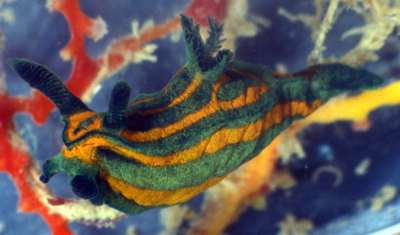
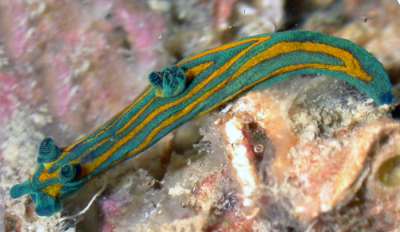
Tambja tentaculata
Pola, Cervera & Gosliner, 2005
Order: NUDIBRANCHIA
Suborder: DORIDINA
Superfamily: ANADORIDOIDEA
Family: Polyceridae
Subfamily: Nembrothinae
DISTRIBUTION
Described from Apra Harbor, Guam, but Forum records from Borneo and Indonesia show it is a wider dsitribution in the tropical Indo-West Pacific.
PHOTO
Upper:Apra Harbor, Western Shoals, Guam, 8 m; 11 July 2003. 20 mm. Carlson & Hoff -D.188. Found associated with the the red & yellow gorgonian (Acabaria?) in the background. Photo: Clay Carlson & Patty Jo Hoff. Lower: Apra Harbor, Western Shoals, Guam. Depth: 14 meters. Length: 17 & 20 mm alive. 15 September 2004. Photographer: Marta Pola.
The background colour of the body is green with several relatively broad longitudinal yellow bands. There are four dorsal yellow bands, two inner bands arising from the inside edge of the rhinophore sheaths and running back to the gills pocket, and two outer submarginal outer bands arising from the outside edge of the sheath. Tye submarginal bands run back behind the gill pocket and join in the posterior midline. There is also a short median yellow band that runs back a short distance from the gill pocket. From the base of the rhinophores, the submarginal yellow band on each side joins it counterpart on the other side in a loop around the anterior mantle, just in from the edge. On the sides of the body there is a yellow band just below the mantle which runs around the head, above the lateral slot and oral tentacles, and down each side of the body to near the posterior tip of the foot. A second band runs down the side of the body just in from the edge. These two lateral bands join each other near the posterior tip. They do not join their counterparts on the other side. In the photo available to me there is some distinct dark bluish pigmentation which along the distal edge of the oral tentacles, the edge of the rhinophore sheaths, and the extreme edge of the anterior mantle. The rhinophore club is also tinged with dark blue, and so are the gill pinnae. The edge of the yellow bands appears to be outlined by a thin dark line.
This species is unusual in having large elongate oral tentacles, more characteristic of a species of Roboastra than a species of Tambja. Its internal anatomy however is typical of Tambja. The only other species with similar oral tentacles is Tambja gratiosa from the western Atlantic. It is very similar in colour to Tambja olivaria [seen Tambja affinis colour group page for comparison].
-
Pola, M., Cervera, J.L. & Gosliner, T. (2005) Four New Species of Tambja Burn, 1962 (Nudibranchia: Polyceridae) from the Indo-Pacific. Journal of Molluscan Studies, 71: 257-267
Rudman, W.B., 2005 (August 17) Tambja tentaculata Pola, Cervera & Gosliner, 2005. [In] Sea Slug Forum. Australian Museum, Sydney. Available from http://www.seaslugforum.net/find/tambtent
Related messages
Tambja tentaculata from Raja Ampat, Indonesia
October 23, 2008
From: Fiona Kwok
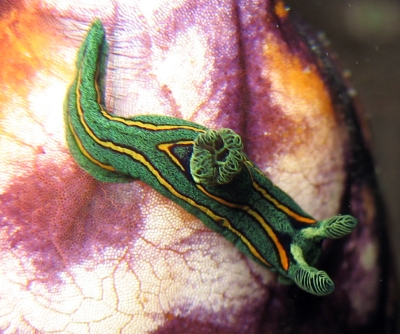
Hi,
Another unknown nudi species...
Locality: Misool, Raja Ampat, 12 - 15 metres, Indonesia, Ceram Sea, 19 February, 2007, Reef Wall. Length: 2 cm. Photographer: Fiona Kwok.
Could you help identify?
Thanks,
Fiona
fi.kwok@gmail.com
Kwok, F, 2008 (Oct 23) Tambja tentaculata from Raja Ampat, Indonesia. [Message in] Sea Slug Forum. Australian Museum, Sydney. Available from http://www.seaslugforum.net/find/20789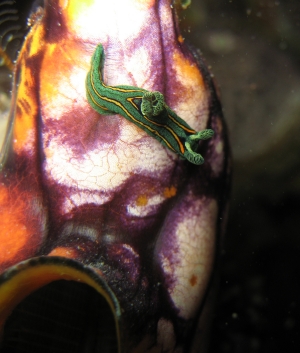
Dear Fiona,
This is Tambja tentaculata. I assume its presence on the large ascidian is a co-incidence, because although species of the related genus Nembrotha feed on ascidians, the species of Tambja which we have information for, all feed on bryozoans. However Tambja tentaculata is quite interesting because it is one of a small group of species of Tambja which have large flattened lobes on each side of the mouth, and we have no idea why they differ from other species in this way. As we don't know just what this species feeds on, these lobes could indicate a non-bryozoan feeding habit, so if anyone sees it feeding or has a photo of it apparently feeding, it would be interesting to hear from you..
Best wishes,
Bill Rudman
Tambja tentaculata from West Papua
June 6, 2007
From: Franco Banfi
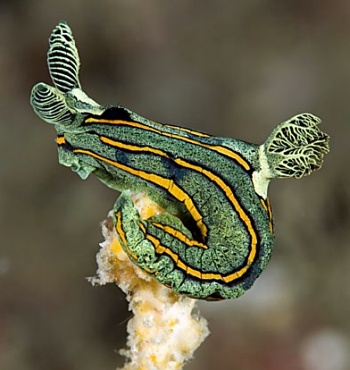
I cannot identify this nudibranch
Locality: Raja Ampat, West Papua, Indonesia 20 metres, Indonesia, Pacific ocean, 16 December 2006, muddy. Length: 2 cm. Photographer: Franco Banfi.
Franco Banfi
photo@banfi.ch
Franco, B., 2007 (Jun 6) Tambja tentaculata from West Papua. [Message in] Sea Slug Forum. Australian Museum, Sydney. Available from http://www.seaslugforum.net/find/19234Dear Franco,
This is Tambja tentaculata.
Best wishes,
Bill Rudman
Re: Tambja or Roboastra ? from Indonesia
April 20, 2007
From: Budi Ramadi Jerry
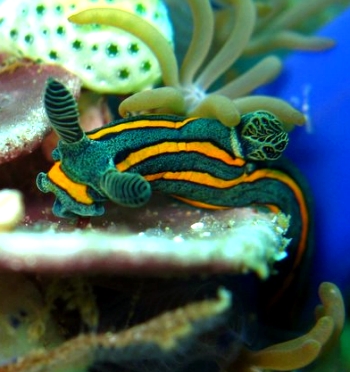
Concerning message #16540:
Thank you for the explanation; the body color is just different if we compare it with the other photo. I have taken photo of Tambja tentaculata with a bit different body color around Komodo island (attached).
Locality: Komodo Island, 20 meters, Indonesia, Lesser Sunda, 24 October 2006, Clear open water. Length: 2.5cm. Photographer: Budi Ramadi Jerry.
Budi Ramadi Jerry
brjerry@gmail.com
Jerry, B.R., 2007 (Apr 20) Re: Tambja or Roboastra ? from Indonesia. [Message in] Sea Slug Forum. Australian Museum, Sydney. Available from http://www.seaslugforum.net/find/19830Dear Jerry,
Thanks for the photo. Yes I agree that your first animal was quite different in colour and is probably a different species. However many of these species are known from only a few specimens so we still have to find out just how variable they are in colour. Since they are not that common this is quite a slow process, but sorting out these problems is what makes the study of sea slugs so interesting.
Best wishes,
Bill Rudman
Re: Tambja tentaculata from Borneo
March 15, 2007
From: Teresa Zuberbühler
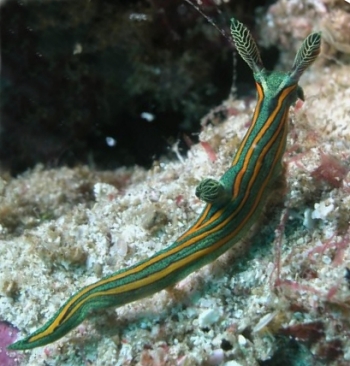
Dear Bill
I have also found Tambja tentaculata on a dive in Rinca (a small island in the Komodo Islands). It was very small, so I first thought it was a juvenile of some Roboastra species. I am glad to find it on your pages. This nudibranch seems to live not only in Guam but also in Indonesia.
Locality: Cannibal rock, Rinca island, ca. 15m, Indonesia, Pacific, 22. July 2004, cold water, small coral reef. Length: 3 to 4cm. Photographer: Teresa (Zubi) Zuberbühler.
Teresa Zubi
webmaster@starfish.ch
Teresa Zuberbühler, 2007 (Mar 15) Re: Tambja tentaculata from Borneo. [Message in] Sea Slug Forum. Australian Museum, Sydney. Available from http://www.seaslugforum.net/find/19652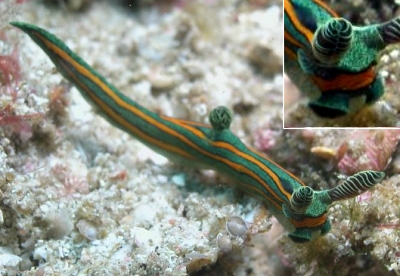
Dear Zubi,
Thanks for this. There are a couple of aniamls on the Forum which I have tentatively identified as Tambja tentaculata, but your specimen is the first one I can definitely say is that species. With the message from Borneo [#14883] we can now say with some certainty that this species is found outside Guam.
Best wishes,
Bill Rudman
Re: Tambja or Roboastra ? from Indonesia
May 9, 2006
From: Marta Pola
Concerning message #16009
Dear Bill,
I am also very confused with these species. I would like to have this specimen in order to dissect it since I could only check specimens from Guam. Nevertheless, what I can confirm is that T. tentaculata is phylogenetically very close to Roboastra species, since in all my morphological and molecular analysis there is a clade composed of Roboastra + Tambja tentaculata (submitted). Thus, the large and dorso-laterally grooved oral tentacles seems to be a very good character for this clade.
Regarding the specimen from Indonesia, I am not very sure if it is T. tentaculata. In this case, the colour of the gill, the rhinophores and the oral tentacles are quite different from it. T.tentaculata lacks blue pigmentation since the whole gill, rhinophores and oral tentacles are green.
My analyses also show that Tambja Burn, 1962 is not a monophyletic genus.
Best regards
Marta Pola
marta.pola@uca.es
Pola, M., 2006 (May 9) Re: Tambja or Roboastra ? from Indonesia. [Message in] Sea Slug Forum. Australian Museum, Sydney. Available from http://www.seaslugforum.net/find/16540Dear Marta,
Thanks for your message. I must say it looks different to me. I guess I will leave it with T. tentaculata at the moment so it doesn't get lost among the 'unidentified'
Best wishes,
Bill Rudman
Tambja or Roboastra? from Indonesia
May 1, 2006
From: Budi Ramadi Jerry
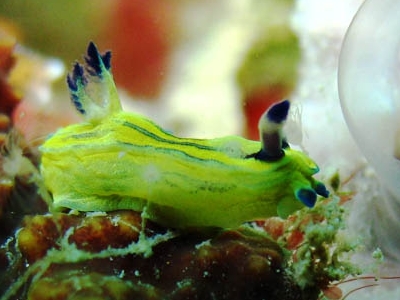
Appreciate if you can help me identify this one.
Locality: Sangiang Island, Sunda Strait, West Java, 20 meters, Indonesia, Sunda strait, 25 Feb 2006. Length: 20 mm. Photographer: Budi Ramadi Jerry.
Thanks.
Budi Ramadi Jerry.
brjerry@gmail.com
Jerry, B.R., 2006 (May 1) Tambja or Roboastra? from Indonesia. [Message in] Sea Slug Forum. Australian Museum, Sydney. Available from http://www.seaslugforum.net/find/16009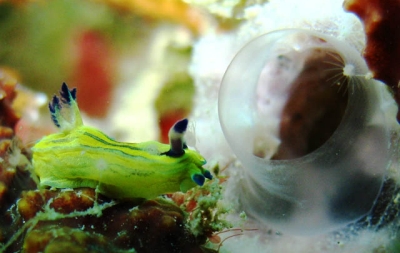
Dear Jerry,
You are right to be hesitant with this. It is probably a species of Tambja, but the large oral tentacles are very reminiscent of a species of Roboastra. One possibility is Tambja tentaculata but I am beginnig to wonder if we are right to push everything with large oral tentacles and a greenish colour into that species. Perhaps Marta Pola can help.
Best wishes,
Bill Rudman
Tambja tentaculata from Bali
February 14, 2006
From: Hengky Dotulong
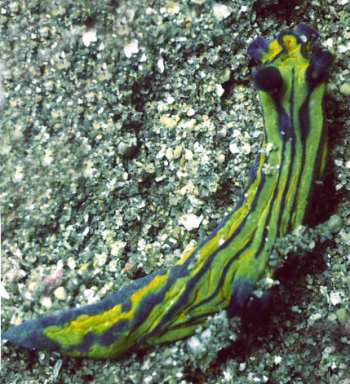
I saw this yesterday in Amed, North Bali. I tried to find it in the Debelius Nudibranch book, and it seems to resemble a Roboastra or Tambja, but I am not sure which.
Locality: Lipah, Amed, Karang Asem, Bali, Indonesia, Lombok Strait. Depth: 12 metres. Length: 2 - 3 cm . 20 November 2005. Black Sand. Photographer: Hengky Dotulong
I'm hoping that you can help! Thanks so much, I look forward to hearing back from you and enjoy your website very much.
Best regards,
Hengky Dotulong
hengky@dotulong.net
Hengky Dotulong, 2006 (Feb 14) Tambja tentaculata from Bali. [Message in] Sea Slug Forum. Australian Museum, Sydney. Available from http://www.seaslugforum.net/find/15323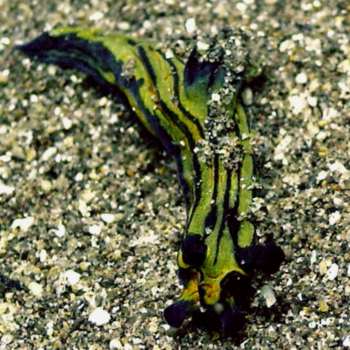
Dear Hengky,
I think this is Tambja tentaculata. We still have a lot to learn about these animals so I could be wrong. This species normally has yellow stripes with black edging to the yellow lines. What I suspect happens is that the yellow lines contract so only the black parts shows. If you look at the juvenile in Marta Pola's message [#14593] there is no sign of the yellow.
Best wishes,
Bill Rudman
Tambja tentaculata from Borneo
October 10, 2005
From: Sylvain Le Bris
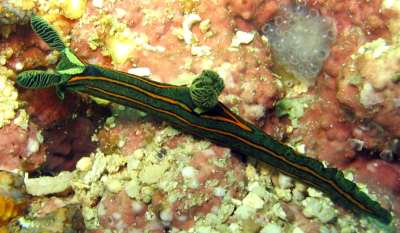
Hi,
Can you help me to identify this nudibranch ?
Locality: Mabul Island, Borneo, Malaysia. Depth: 20 m. Length: 6 cm. 09 September 2005. Photographer: Sylvain Le Bris
Sylvain Le Bris
sylvain.lebris@freesbee.fr
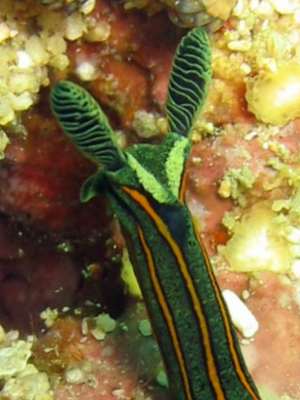
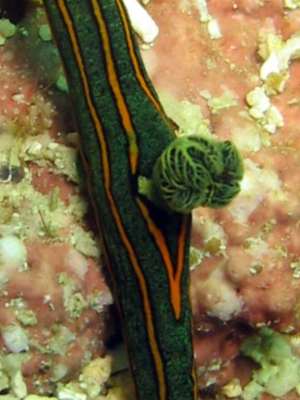
Dear Sylvain,
I think this is the recently describe Tambja tentaculata. In general the colour pattern is the same and it is quite large oral tentacles. I maybe wrong however because your animal lacks a ventral yellow line on the mantle and has a greenish white V shaped mark on the head which I haven't seen in photos of T. tentaculata. However your animal may have a developmental abnormality. If you look just behind the point of the V, there is a dark oval patch which an unpigmented region above the eye, quite often seen in this group. In your animal there seems to be only one of these and its almost in the midline. Normally there are two, one behind each rhinophore. If I am right it looks like your animal is 'one-eyed' and unusually narrow-bodied, which could explain the absent median line.
Best wishes,
Bill Rudman
Tambja tentaculata - some more photos
August 19, 2005
From: Marta Pola

Dear Bill,
I was just writing my email about Tambja tentaculata when I saw Clay Carlson's last message [#14591] . To add a bit more information about this new species, here are three more pictures of it. All of them were taken in Guam. You can see that both specimens have some differences in the colouration but I have examined both of them and they are Tambja tentaculata. I also attach a picture of the foot where you can see by transparency some internal features.
Locality: Apra Harbor, Western Shoals, Guam. Depth: 14 meters. Length: 17 & 20 mm alive. 15 September 2004. Photographer: Marta Pola
Best regards
Marta Pola
marta.pola@uca.es
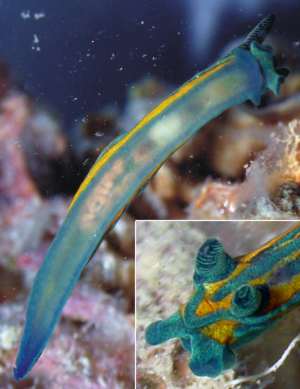
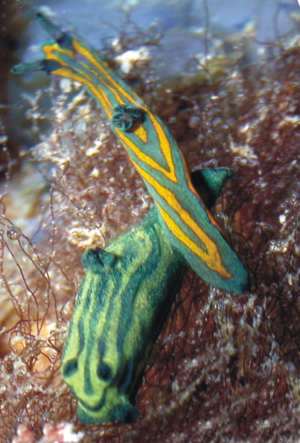
Thanks Marta,
Its good to get some more information on this species, especially the colour form with little yellow pigmentation. I will have to change the colour description on the Fact Sheet to reflect the arrangement of the dorsal longitudinal yellow bands. Both you and I say there are three bands, one median and one submarginal on each side. However from these photos there appears to be four dorsal bands. There are two inner bands arising from the inside edge of the rhinophore sheaths and the two submarginal outer bands arising from the outside edge of the sheath.
Best wishes,
Bill Rudman
Tambja tentaculata from Guam
August 18, 2005
From: Clay Carlson & Patty Jo Hoff

Dear Bill,
To complete the Tambja collection from Pola et al (2005) [see #14574] here is Tambja tentaculata
Locality: Apra Harbor, Western Shoals, Guam, 8 m; 11 July 2003. 20 mm. Carlson & Hoff -D.188. Found associated with the the red & yellow gorgonian (Acabaria?) in the background.
It is difficult to tell whether the animals found in the harbour are here naturally or were introduced due to the heavy shipping.
Clay Carlson & Patty Jo Hoff
clay.carlson@kuentos.guam.net
Carlson, C. & Hoff, PJ, 2005 (Aug 18) Tambja tentaculata from Guam. [Message in] Sea Slug Forum. Australian Museum, Sydney. Available from http://www.seaslugforum.net/find/14591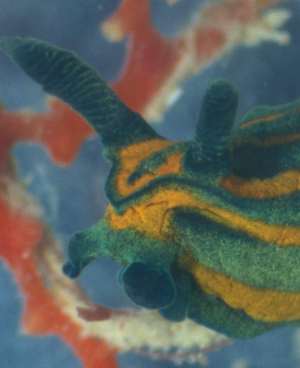
Dear Clay & Patty Jo,
Thanks for this photo of what is at present a rare species, known only from Apra Harbour. Perhaps the publicity will bring a few more records to light from elsewhere. I have included a close-up of the head alongside because it shows the large enrolled oral tentacles which gave this species its name. These tentacles are more characteristic of a species of Roboastra then a species of Tambja. In your photo you can also see the 'lateral slot' as a dark line midway between the rhinophores and the oral tentacles.
As I mentioned when recently discussing Tambja gratiosa [message #14519], the long Roboastra-like oral tentacles in T. tentaculata, which on all other anatomical features is a species of Tambja, may explain the similar long tentacles in T. gratiosa, which was reported by Bergh to have radular teeth characteristic of Tambja.
While preparing a Fact Sheet for this species, and adding it to the Tambja affinis colour group page, I noticed its very close similarity in colour to Tambja olivaria. I wonder if the enrolled oral tentacles can partly unroll? If so they would look very like the large flaps in the photos of T. olivaria on the Fact Sheet for that species.
Best wishes,
Bill Rudman
